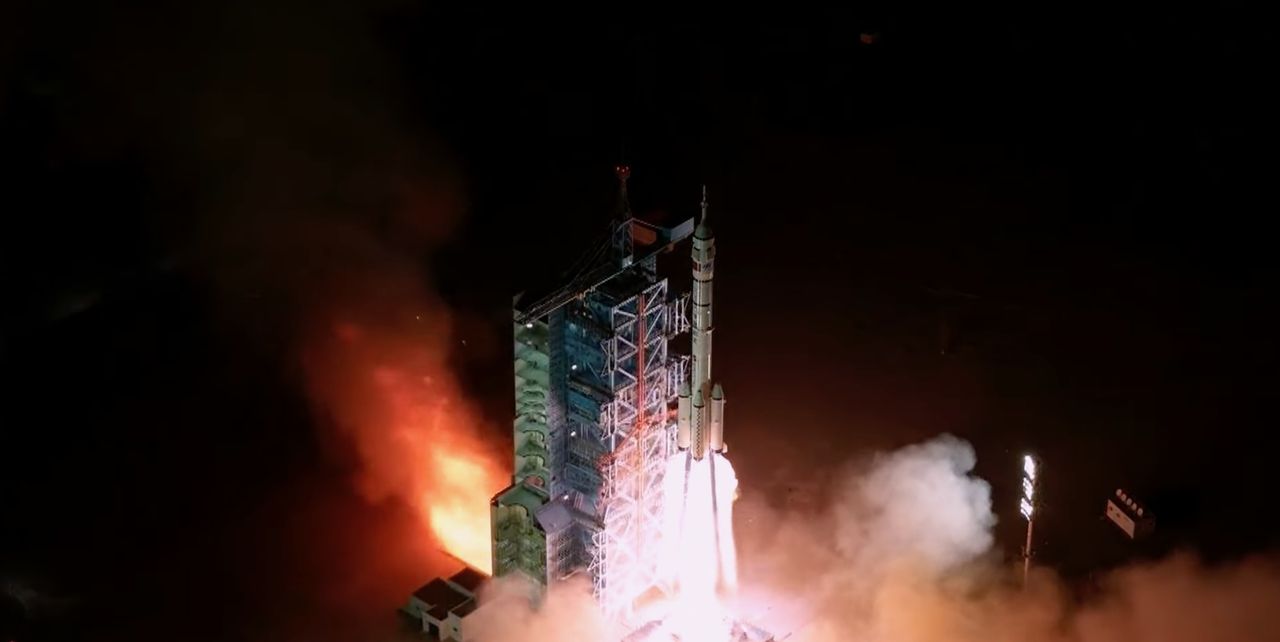Science
Shenzhou 21 Astronauts Face Uncertainty Aboard Tiangong Station

Three astronauts aboard China’s Tiangong space station are currently without a reliable means of return to Earth following an unexpected emergency with their planned ride home. The crew members of the Shenzhou 21 mission arrived at Tiangong on October 31, 2023, for a six-month stay. However, their spacecraft was recently repurposed to assist another crew, leaving the Shenzhou 21 astronauts in a precarious situation.
On the evening of November 13, 2023, the Shenzhou 21 spacecraft was launched with three astronauts from the Shenzhou 20 mission. This decision came after the Shenzhou 20 vehicle sustained damage from a space-debris strike, rendering it unfit for transporting its crew back to Earth. As a result, the Shenzhou 21 astronauts—commander Zhang Lu, along with fellow crew members Zhang Hongzhang and Wu Fei—remain aboard Tiangong without a safe lifeboat.
Despite the immediate risks, officials indicate that this situation is expected to be temporary. China maintains a standby Long March 2F rocket and Shenzhou spacecraft at the Jiuquan Satellite Launch Center, ready for deployment during crewed missions. According to SpaceNews’ Andrew Jones, this standby vehicle could be launched to the station in as little as 8.5 days if an emergency arises, and preparations for this scenario have likely already commenced.
Chinese space officials have announced intentions to send the Shenzhou 22 spacecraft to Tiangong. However, no specific timeline has been provided, with officials stating that the launch will occur “at an appropriate time in the future.” With each passing day spent in orbit without a secure means of return, the urgency for a timely launch increases.
The situation faced by the Shenzhou 21 crew echoes the experience of NASA astronauts Butch Wilmore and Suni Williams, who spent an extended duration aboard the International Space Station (ISS) in 2024 due to complications with Boeing’s Starliner capsule. Unlike the ISS, which always had non-Starliner lifeboats available, the Shenzhou 21 astronauts lack immediate options for evacuation. The Shenzhou 20 spacecraft, currently docked at Tiangong, has sustained damage that prevents it from safely returning its crew.
The state-run Xinhua news outlet reported that the Shenzhou 20 spacecraft “does not meet the requirements for the astronauts’ safe return and will remain in orbit to continue relevant experiments,” according to the China Manned Space Agency.
The Shenzhou 21 mission represents the tenth crewed operation involving the Tiangong space station, a facility approximately 20% the mass of the ISS. Commander Zhang Lu, aged 48 and a veteran of previous missions, leads a crew that includes Zhang Hongzhang and Wu Fei, the latter of whom is noted as the youngest member of China’s astronaut corps.
As the Shenzhou 21 astronauts continue their work aboard Tiangong, the focus remains on ensuring their safety and preparing for a swift resolution to their current predicament. The Chinese space program aims to minimize risks for its astronauts, and the timely launch of the Shenzhou 22 spacecraft will be critical in addressing the existing challenges faced by the crew.
-

 Science3 weeks ago
Science3 weeks agoOhio State Study Uncovers Brain Connectivity and Function Links
-

 Politics3 weeks ago
Politics3 weeks agoHamas Chief Stresses Disarmament Tied to Occupation’s End
-

 Entertainment3 weeks ago
Entertainment3 weeks agoMegan Thee Stallion Exposes Alleged Online Attack by Bots
-

 Science4 weeks ago
Science4 weeks agoResearchers Challenge 200-Year-Old Physics Principle with Atomic Engines
-

 Entertainment3 weeks ago
Entertainment3 weeks agoPaloma Elsesser Shines at LA Event with Iconic Slicked-Back Bun
-

 World2 weeks ago
World2 weeks agoFDA Unveils Plan to Cut Drug Prices and Boost Biosimilars
-

 Top Stories3 weeks ago
Top Stories3 weeks agoFederal Agents Detain Driver in Addison; Protests Erupt Immediately
-

 Business3 weeks ago
Business3 weeks agoMotley Fool Wealth Management Reduces Medtronic Holdings by 14.7%
-

 Entertainment2 weeks ago
Entertainment2 weeks agoBeloved Artist and Community Leader Gloria Rosencrants Passes Away
-

 Business3 weeks ago
Business3 weeks agoHome Depot Slashes Prices on Halloween Favorites Up to 75%
-

 Top Stories3 weeks ago
Top Stories3 weeks agoOrioles Hire Craig Albernaz as New Manager Amid Rebuild
-

 Business2 weeks ago
Business2 weeks agoShutdown Impacts Millions as Deadline Approaches, Pressures Congress









